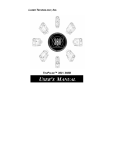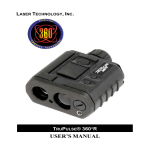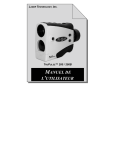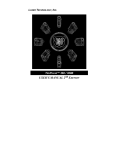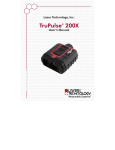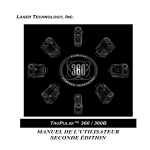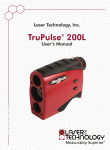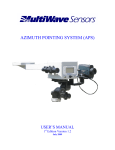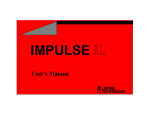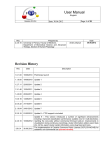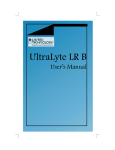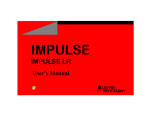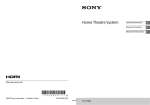Download LTI TruPulse User`s Manual - 2nd Edition
Transcript
LASER TECHNOLOGY, INC. TRUPULSE™ 200 / 200B USER'S MANUAL LTI TruPulse 200 / 200B User’s Manual Second Edition - Part Number 0144773 Copyright Notice: Information in this document is subject to change without notice and does not represent a commitment on the part of Laser Technology Inc. No part of this manual may be reproduced in any form or by any means, electronic or mechanical, including photocopying, recording, or information storage and retrieval systems, for any purpose other than the purchaser's personal use, without the express written consent of Laser Technology, Inc. Copyright © Laser Technology, Inc., 2005. All rights reserved. First Edition: September 2005 Second Edition: October 2005 Patents: This product is covered by pending patent applications and/or the following issued U.S. Patents: 6,445,444; 5,612,779; 6,057,910; 6,226,077. Trademarks: Criterion, Impulse, and TruPulse are trademarks of Laser Technology, Inc. The Bluetooth trademarks are owned by Bluetooth SIG, Inc. All other trademarks are the property of their respective owners. LTI Contact Information: Laser Technology, Inc. 7070 S. Tucson Way Centennial, CO 80112-3921 USA Phone: 1-303-649-1000 1-800-790-7364 (USA and Canada) Fax: 1-303-649-9710 Web Site: www.lasertech.com Email: [email protected] TruPulse Reference Information: Record information about your TruPulse in the table below. You can find this value: Serial Number Firmware Revision Numbers On the serial number sticker affixed to the TruPulse. See page 13 for information. Value Main: Auxiliary: Laser Technology, Inc. TruPulse™ 200 / 200 B User's Manual Languages 1. English 2. Español 3. Français 4. Deutsch 5. 日本語 6. 汉语被简化 LTI TruPulse User’s Manual - Table of Contents Page 1 Table of Contents Precautions ............................................................................................ Section 1 - Introducing the LTI TruPulse ............................................. 2 3 Operating Modes ................................................................................................................... Unpacking Your TruPulse ..................................................................................................... Basic Package ............................................................................................................... Compatible Accessories ............................................................................................... Understanding How the TruPulse Works ............................................................................. Laser Range Sensor ...................................................................................................... TruTargeting ................................................................................................................. Tilt Sensor .................................................................................................................... Digital Processor .......................................................................................................... 3 4 4 4 4 4 4 5 5 Section 2 - Quick Start .......................................................................... Section 3 - Basic Operations ................................................................ 6 7 Batteries ................................................................................................................................. Installation .................................................................................................................... Low Battery Warning ................................................................................................... Buttons ................................................................................................................................... Powering OFF the TruPulse ......................................................................................... Display Indicators .................................................................................................................. Display Indicator Test .................................................................................................. Error Codes ............................................................................................................................ Eyepiece ................................................................................................................................. Diopter Adjustment Ring ...................................................................................................... Firmware Revision Numbers ................................................................................................ Neck Strap ............................................................................................................................. 7 7 7 8 9 9 11 11 12 12 13 13 Section 4 - System Setup Modes ......................................................... 14 Units ....................................................................................................................................... Bluetooth Enable ................................................................................................................... Tilt Sensor Alignment ........................................................................................................... 15 16 17 Section 5 - Measurement Modes .......................................................... 19 Distance Measurements ......................................................................................................... Notes about Measurements ................................................................................................... Inclination Measurements ..................................................................................................... Height Routine ..................................................................................................................... 19 20 20 20 Section 6 - Target Modes ...................................................................... 23 Laser Technology, Inc. TruPulse User's Manual 2nd Edition Page 2 Section 7 - Care & Maintenance ........................................................... Section 8 - Serial Data Interface ........................................................... 24 25 Format Parameters ................................................................................................................. Serial Port .............................................................................................................................. Download Instructions .......................................................................................................... Optional Remote Trigger ...................................................................................................... Download Message Format ................................................................................................... Query ..................................................................................................................................... Example Version ID Message ...................................................................................... Download Message Formats ................................................................................................. Horizontal Vector (HV) Download Messages ............................................................. Height (HT) Download Messages ................................................................................ 25 26 26 26 27 27 27 28 28 29 Section 9 - Specifications ..................................................................... Section 10 - Troubleshooting ............................................................... 30 32 Precautions Avoid staring directly at the laser beam for prolonged periods. The TruPulse™ is designed to meet FDA eye safety requirements and is classified as eye-safe to Class 1 limits, which means that virtually no hazard is associated with directly viewing the laser output under normal conditions. As with any laser device, however, reasonable precautions should be taken in its operation. It is recommended that you avoid staring into the transmit aperture while firing the laser. The use of optical instruments with this product may increase eye hazard. Never attempt to view the sun through the scope. Looking at sun through the scope may permanently damage your eyes. Never point the unit directly at the sun. Exposing the lens system to direct sunlight, even for a brief period, may permanently damage the internal components. Avoid direct sun exposure on the eyepiece. Exposing the eyepiece to direct sunlight can damage the internal display. Do not expose the instrument to extreme temperatures. TruPulse™ components are rated for a temperature range of -4° F to +140° F (-20° C to +60° C). Do not expose the instrument to temperatures outside this range whether in use or in storage. Section 1 - Introducing the LTI TruPulse Page 3 Section 1 - Introducing the LTI TruPulse Congratulations on the purchase of your TruPulse, a cost-effective professional rangefinder. This compact and lightweight laser is a flexible tool for your measurement needs. The TruPulse includes five measurement modes, five target modes, and serial data output. Features of the TruPulse: • Crystal clear optics and the heads up display lets you keep your eye on the target. • "Thru-the-lens" viewing eliminates parallax issues so you know the laser energy is traveling directly along your line of sight. • The laser sensor and integrated tilt sensor measure slope distance, horizontal distance, vertical distance, inclination, or instantly calculate the height of any object. • The Target Mode allows you to select or eliminate targets; which helps you take the most accurate measurement possible in a variety of field conditions. • Adjustable eyepiece provides comfortable viewing for eye or sunglass wearers. • Measurement data is available for download to remote PC or Pocket PC. Data communication via wired RS232 serial (standard) or go wireless with the Bluetooth option, TruPulse 200B. 1. 2. 3. 4. 5. 6. 7. FIRE button (power ON) (UP) button (DOWN) button Adjustable Eyepiece Diopter Adjustment Ring Tripod / Monopod mount Attachment Point (for neck strap and eyepiece cover) 8. RS232 Data Port 9. Battery Compartment Cover 10. Receive Lens 11. Transmit Lens / Viewing Objective Figure #1 Operating Modes Measurement Modes Slope Distance Vertical Distance Horizontal Distance Inclination 3-Point Height Routine **Advanced Targeting Modes. Target Modes Standard Continuous** Closest** Farthest** Filter** System Setup Modes Units Selection Bluetooth Enable (TruPulse 200B only) Tilt Sensor Alignment Laser Technology, Inc. TruPulse User's Manual 2nd Edition Page 4 Unpacking Your TruPulse When you unpack your TruPulse, check to make sure that you received everything that you ordered, and that it all arrived undamaged. Basic Package • • • • • • TruPulse 200 or TruPulse 200B (integrated Bluetooth®) Carrying Case Eyepiece Cover Lens Cloth Neck Strap User's Manual Compatible Accessories ● Data Download Cable ● Foliage Filter ● Tripod / Monopod To learn more about any of the items listed above, please contact your LTI Sales Representative or an Authorized LTI Distributor. Understanding How the TruPulse Works The TruPulse consists of a laser range sensor, an integrated tilt sensor, and a digital processor. The TruPulse has three buttons that access the unit's internal software, which controls the integrated sensors. Laser Range Sensor The laser range sensor emits invisible, eye safe, infrared energy pulses. The TruPulse determines distance by measuring the time it takes for each pulse to travel from the rangefinder to the target, and back. The LASER indicator is displayed whenever the laser is being transmitted. The laser may be active for a maximum of 10 seconds. Once the target is acquired or the laser has timed out, you can release the FIRE button. The TruPulse has a broad spectrum of sensitivity and can work with both reflective and non-reflective targets. See TruTargeting (below) for information about high quality and low quality targets. TruTargeting The TruPulse automatically provides the best accuracy and acquisition distance to a given target. Maximum measurement distance varies with target quality and environmental conditions. When shooting to a non-reflective target, the maximum measurement distance is approximately 1,000 meters (3,280 feet). When shooting to a reflective target, the maximum measurement distance is approximately 2,000 meters (6,560 feet). Section 1 - Introducing the LTI TruPulse Page 5 When selecting a target, you should consider the following: • Color: The brighter the color, the longer the range. • Finish: Shiny finishes provide longer range than dull finishes. • Angle: Shooting perpendicular to a target provides better range than shooting to a target at a sharp angle. • Lighting Conditions: Overcast skies will increase the unit's maximum range, and sunny skies will decrease the unit's maximum range. Target quality has an effect on the precision of measurements. A high quality target will result in a measurement that includes one decimal place (tenths). A low quality target will result in a measurement that is a whole number. Examples: • • 120 feet (meters / yards) indicates a measurement was made to a low quality target. o Accuracy: ±1 yd (±1 m). 120.0 feet (meters / yards) indicates a measurement was made to a high quality target. o Feet are shown in half-unit increments (.0 or .5). o Meters and Yards are shown in tenth-unit increments (.0 - .9). o Accuracy: ±1 foot (±30 cm). Tilt Sensor The integrated tilt sensor measures vertical angles that the TruPulse uses to calculate height and elevation and to determine slope-reduced horizontal distances. The instrument held level is at 0°, and is rotated up through +90°, and down through -90°. • The laser is not active in the Inclination (INC) Measurement Mode. • . However in (1) the Generally, the inclination is measured when you press Continuous Target Mode and (2) in the Height Measurement Mode, the inclination reading appears in the Main Display and the display updates as your aiming point changes as long as you press . In these two situations, the measured inclination is based upon the aiming point when you release . Digital Processor The TruPulse includes LTI's proprietary ASIC chip (Application-Specific Integrated Circuit). The ASIC chip combined with high-speed CPU processing allows the TruPulse to deliver accurate and fast measurements. Laser Technology, Inc. TruPulse User's Manual 2nd Edition Page 6 Section 2 - Quick Start 1. Install the batteries (page 7). 2. 3. Press to power ON the TruPulse. Select a target such as a tree or a building. For this example, the target should be approximately 250 feet (82 yards or 75 meters) from you. Look through the eyepiece (see Figure #2) and use the crosshair to aim to the target. The in-scope LCD should look similar to Figure #3A. o If the HD indicator is not displayed, press or until the HD indicator is displayed. 4. 5. . The LASER status indicator is Press-and-hold displayed while the laser is active (Figure #3B). The laser will remain active for a maximum of 10 seconds while acquiring data about the target. o 6. Figure #2 If the target is not acquired, release this step. and repeat Release once the distance is displayed (Figure #3C). The measurement will flash one time and then will be displayed steady until you press a button or the unit powers OFF. o Press or to scroll through the measurement modes and see the results acquired for each function. o Repeat steps #3-#6 above to take another measurement. o Simultaneously press-and-hold and for 4 seconds to power OFF the TruPulse. Figure #3 Section 3 - Basic Operations Page 7 Section 3 - Basic Operations Batteries Installation You may use two AA batteries (or 1 CRV3 battery) to power the TruPulse. The CRV3 battery provides approximately twice the usage time of the AA batteries. 1. 2. 3. Remove the battery compartment cover by gently pressing and sliding the cover in and down as shown in Figure #4A. If using AA batteries, install the batteries as shown in Figure #4B. Batteries must be oriented (+/-) as shown in Figure 4B and also on the indication sticker found inside the battery compartment. o If using one CRV3 battery, the battery compartment is designed so the battery will only fit one way. Replace the battery compartment cover by aligning the tabbed edges of the cover with the grooved edges of the battery compartment, and slide the cover up until the tab locks into position. Figure #4 Low Battery Warning The TruPulse monitors the incoming battery voltage. Figure #5 shows the location of the battery status indicator. • • When the voltage drops below 2.2V, the BATT status indicator flashes every 5 seconds, alternating with the normally displayed information. o You should replace the batteries as soon as possible. When the voltage drops below 2.0V, the BATT status indicator stops flashing and is displayed steady. At this point, system operation is locked. o You must replace the batteries to return to normal system operation. Figure #5 Laser Technology, Inc. TruPulse User's Manual 2nd Edition Page 8 Buttons The TruPulse has three buttons. With the TruPulse in your right hand and looking through the is located on top, near your index finger and eyepiece, of the instrument. and are located on the left side Measurement Modes Powers ON the unit. Distance Measurement: fires the laser. Inclination: Release “locks” tilt sensor in (1) Height Measurement Mode and (2) Continuous Target Mode. Height Routine (HD) Fires the laser. (INC) Release “locks” tilt sensor. Target Modes System Setup Modes Selects option and returns to the Measurement Mode. Aligning Tilt Sensor When “DonE” message displayed, exits the routine and returns to the Measurement Mode. Measurement Modes Press to scroll to the previous Measurement Mode. (UP) Press-and-hold 4 seconds to access the Target Mode. Height Routine Target Modes System Setup Modes Clears the last measurement and re-displays the previous prompt. Press to scroll to the previous option. Measurement Modes Press to scroll to the next Measurement Mode. (DOWN) Press-and-hold 4 seconds to access the System Setup Modes. Height Routine Target Modes System Setup Modes Exits the Height Routine. Press to scroll to the next option. Section 3 - Basic Operations Page 9 Powering OFF the TruPulse To power OFF the unit, simultaneously press-and-hold and for 4 seconds. To conserve battery power, the TruPulse powers itself OFF if no button presses are detected after a specified length of time: o TruPulse 200 (or 200B with Bluetooth OFF): 2 minutes o TruPulse 200B with Bluetooth ON: 10 minutes Display Indicators Figure #6 shows the LCD in-scope display. The TruPulse’s internal software is organized into options. Each option represents a specific measurement or setup function and has a corresponding display indicator. Refer to the figure and table below for information about each indicator. Figure #6 Main Display Measurement Units 888.8.8 YARDS METERS FEET DEGREES Crosshair Displays messages and measurement results. Distance measurement units. Selection available in the System Setup Modes. Inclination measurement units. Serves as the aiming point reference, both horizontally and vertically. Laser Technology, Inc. TruPulse User's Manual 2nd Edition Page 10 Status Indicators Target Modes BATT Flashing: battery voltage is low. Steady: battery voltage is too low for system operation. Not Visible: battery voltage is within acceptable range. LASER Visible: laser is firing. Not Visible: laser is not active. MULTI Multiple targets have been logged in the Closest or Farthest target mode. CONT The unit continuously acquires targets and displays measurements while is held down. The distance to the most recently acquired target is displayed. CLOSEST FARTHEST Filter (‘F’ appears as the left most character of the Main Display to indicate Filter Mode is active. Standard (No display indicator) The unit logs multiple targets while is held down. Of the targets acquired, the distance to the closest target is displayed. The unit logs multiple targets while is held down. Of the targets acquired, the distance to the farthest target is displayed. Similar to Standard, single shot mode, but the laser’s sensitivity is reduced to only detect pulses returned from a reflector. The optional foliage filter must be used in conjunction with this mode. Standard, single shot strongest target mode. Section 3 - Basic Operations Page 11 Measurement Modes SD Slope Distance Straight line distance between the TruPulse and the target. VD The distance between the target and the Vertical Distance perpendicular to the path of the horizontal distance. HD Horizontal Distance The level distance between the TruPulse and the plane of the target. INC Inclination The angle of inclination between the TruPulse at level and the target. AZ HT Height Not available. Three-step height routine. The final calculation represents the vertical distance between the points on the target represented by ANG1 and ANG2. Display Indicator Test To verify that all display indicators are working properly: 1. 2. . Start with the TruPulse powered OFF, press-and-hold Compare the in-scope display to the Figure #6 (see page 9) to verify that all indicators are working properly. 3. Release to start normal operation. Error Codes Error conditions can occur in a measurement or in the system hardware. To make sure that you never get an erroneous measurement, the TruPulse monitors both system hardware and measurements. When the instrument detects an error condition, it displays and error code instead of a measurement. Error codes appear in the main display and are in the form of “Exx”, where “xx” is an error code number. Figure #7 shows an example error code, E36. Figure #7 Laser Technology, Inc. TruPulse User's Manual 2nd Edition Page 12 If an error code persists: 1. 2. 3. Release and press again to try to retake the measurement. Remove and re-install the batteries and then try to retake the measurement. If the above steps do not resolve the error, contact LTI or an Authorized LTI Distributor for assistance. Refer to the inside front cover for LTI contact information. Eyepiece The adjustable eyepiece (see Figure #8) is designed for comfort and to block extraneous light. To extend the eyepiece, turn the eyepiece counter-clockwise while pulling up. To return the eyepiece to its original position, turn the eyepiece clockwise and push down. To match your personal preference, the eyepiece may be located in any position from fully up to fully down. If wearing eyeglasses or sunglasses, you will find that the fully down position brings the eyepiece lens closer to your eye and gives you a full field of view. Eyepiece Cover: The eyepiece cover protects the internal components from sunlight exposure. The eyepiece cover should be in place whenever the TruPulse is not in use. Figure #8 To attach the eyepiece cover: Feed the thin cord under the metal bar and flare the loop open. Pull the eyepiece cover through the loop and cinch tight. Diopter Adjustment Ring The diopter adjustment ring (see Figure #8) allows you to focus the LCD in-scope display relative to the target for your eye. During assembly, optimum focus is set to infinity. To adjust the LCD focus, turn the diopter adjustment ring to suit your personal preference. Section 3 - Basic Operations Page 13 Firmware Revision Numbers The firmware revision numbers provide manufacturing information about your TruPulse. To display the main and auxiliary firmware revision numbers: 1. Start with the TruPulse powered OFF, press-and-hold . until done. If you release the button too early, power OFF the Do not release TruPulse and repeat step #1. Looking through the eyepiece: o Press to display the main firmware revision number. The display should look similar to the example below. The leftmost character will always be ‘A’ and the remaining 3 digits represent the main firmware revision o 2. number (1.02 in Figure #9). o Figure #9 Press to display the auxiliary firmware revision number. The display should look similar to the example above. The leftmost character will always be ‘b’ and the remaining 3 digits represent the auxiliary firmware revision number (1.08 in Figure #9). Neck Strap To attach the neck strap: Figure #10 Laser Technology, Inc. TruPulse User's Manual 2nd Edition Page 14 Section 4 - System Setup Modes Figure #11 shows an overview of the System Setup Mode which can be accessed from the Measurement Mode. Each option is described separately in the following sections. 1. 2. From the Measurement Mode, press and hold for 4 seconds. “UnitS” will appear in the Main Display. Press or to display the previous or next option. 3. Press to select an option. Figure #11 Section 4 - System Setup Modes Page 15 Units The TruPulse allows you to choose between YARDS, METERS, and FEET for distance measurements. To toggle the units selection: 1. From the Measurement Mode, press for 4 seconds to access the System Setup Mode. “UnitS” will appear in the Main Display. 2. 3. Press Press to select the “UnitS” option. or to display the previous or next distance unit option. 4. Press to select the displayed distance unit and return to the Measurement Mode. Figure #12 Each time the TruPulse is powered ON, it will return to the same unit setting that was last used. Laser Technology, Inc. TruPulse User's Manual 2nd Edition Page 16 Bluetooth Enable ***TruPulse 200B only*** Bluetooth wireless technology is an industry standard specification for short-range wireless connectivity. As a short-range radio link, Bluetooth replaces cable connections between devices allowing you to download measurement data to any Bluetooth enabled PC device such as a laptop PC, Pocket PC, etc. • • TruPulse Bluetooth offers serial port service to connect to an RS-232 style serial connection. It replaces the download cable from the TruPulse to any Bluetooth enabled PC device. TruPulse Bluetooth is a slave device. Bluetooth master devices can detect the TruPulse when the TruPulse is powered ON and the Bluetooth option is enabled. To toggle the Bluetooth selection: 1. From the Measurement Mode, press for 4 seconds to access the System Setup Mode. “UnitS” will appear in the Main Display. 2. Press to display the “bt” option. 3. 4. Press Press to select the Bluetooth Enable Mode. or to display the other “bt” option. 5. Press to select the “bt_on” or “btoFF” and return to the Measurement Mode. Figure #13 Each time the TruPulse 200B is powered ON, it will return to the same Bluetooth setting that was last used. Section 4 - System Setup Modes Page 17 Refer to the instructions below when connecting your TruPulse 200B to another Bluetooth device. This information is provided as a general guideline; please refer to the product documentation for your specific Bluetooth device. 1. 2. 3. 4. Toggle the TruPulse Bluetooth option ON and return to the measurement mode (see previous page). A host device can now detect the Bluetooth communication from the TruPulse. o Refer to the host device documentation for connecting to Bluetooth devices. Use the Bluetooth Manager to scan for the TruPulse Bluetooth module. The TruPulse Bluetooth will be named “TP200B000000” where “000000” is the serial number of your TruPulse 200B. Tap the icon that matches your TruPulse Bluetooth device. Enter: o Passkey = 1111 o Service Selection = SPP Slave o Select (long press) “Connect”. The Bluetooth Manager on the host device should find and display the active connection status. Bluetooth troubleshooting tips: • TruPulse: Verify that the TruPulse Bluetooth option is toggled ON. • Bluetooth enable PC device: Verify that the Bluetooth connection is active. • Verify that the Bluetooth device is physically located within the wireless transmission range of the TruPulse. o Transmission range can vary depending upon (1) position relative to the TruPulse or (2) type of Bluetooth® connection. Tilt Sensor Alignment The tilt sensor is aligned during assembly. In the rare event that your TruPulse suffers a severe drop shock, refer to the instructions below to re-align the tilt sensor. 1. 2. 3. From the Measurement Mode, press for 4 seconds to access the System Setup Mode. “UnitS” will appear in the Main Display. Press to display the “inc” option. to select the “inc” option. The message “CAL_n” appears in the Main Display and Press the display should look similar to Figure #14 (see next page). Laser Technology, Inc. TruPulse User's Manual 2nd Edition Page 18 Figure #14 4. 5. 6. o Press o If "CAL_n" is displayed, press Measurement Mode. to exit the "inc" option and return to the o If "CAL_Y" is displayed, press appears in the Main Display. to align the tilt sensor. The message "CAL_1" or to display the previous or next "CAL" option. Position the TruPulse on a flat, relatively level surface as shown in Figure #15. Use one finger to hold the front of the unit is flat on the surface (indicated by the arrow in Figures #15A and B). o Keep your finger in place and do not lift or raise the TruPulse until step #7 below is completed. Figure #15 Press to store the first inclination measurement. The message “CAL_2” appears in the Main Display. Rotate the TruPulse 180 degrees as shown in Figure #15B above. 7. to store the second inclination measurement and complete the zero offset correction. Press The message “donE” appears in the Main Display. 8. Press to clear the “donE” message and return to the Measurement Mode. Section 5 - Measurement Modes Page 19 Section 5 - Measurement Modes When you power ON the TruPulse, the last used Measurement Mode will be active. Press or to display the previous or next Measurement Mode. Figure #16 shows the five different types of measurements that the TruPulse can take. Slope Distance (SD) Inclination (INC) Horizontal Distance (HD) Vertical Distance (VD) Height Routine (HT) Figure #16 Distance Measurements The basic steps for taking any distance measurement: 1. Look through the eyepiece and use the crosshair to aim to the target. 2. Press-and-hold . The LASER status indicator is displayed while the laser is active. The laser will remain active for a maximum of 10 seconds while acquiring data about the target. o 3. If the target is not acquired in the 10 second period, release and repeat this step. . The measurement will flash one time Once the measurement is displayed, release indicating the measurement was downloaded. Then the measurement will be displayed steady until you press any button or the unit powers OFF. Laser Technology, Inc. TruPulse User's Manual 2nd Edition Page 20 Notes about Measurements • • • Press or to scroll through the individual measurement functions and see the results acquired for each function. o Both inclination and distance are measured in the HD, SD, and VD modes. o Example Range Measurement: HD = 12.5 meters VD = 1.6 meters SD = 12.6 meters INC = 7.3 degrees o When you scroll to the Height Function, the Main Display will be blank and the HD indicator will be flashing. o In the Inclination Mode, the Main Display will be blank for all other measurement functions since the laser is not active when measuring inclination only. The last measurement does not need to be cleared before acquiring your next target. Each time the TruPulse is powered ON, it will return to the same measurement mode that was last used. Inclination Measurements The laser is not active in the Inclination (INC) Measurement Mode. Generally, the inclination is . However in (1) the Continuous Target Mode and (2) in the Height measured when you press Measurement Mode, the inclination reading appears in the Main Display and the display updates as your aiming point changes as long as you press . A = Horizontal Distance B = Top Angle C = Base Angle D = Height Height Routine Height Measurements involve a simple routine that prompts you to take 3 shots to the target: HD, INC base (or top), and INC top (or base). The TruPulse uses these results to calculate the height of the target. Figure #17 shows the three shots required for the height routine. Figure #17 Section 5 - Measurement Modes Page 21 1. Select your target and look through the eyepiece, using the crosshair to aim to your target. The HT indicator displays steady and the HD indicator flashes; prompting you to measure the Horizontal Distance to the “face” of the target. 2. Press-and-hold . The LASER status indicator is displayed while the laser is active. The laser will remain active for a maximum of 10 seconds while acquiring data about the target. The measured horizontal distance appears briefly in the Main Display and then Ang_1 and the INC indicator flashes; prompting you to measure the inclination to base (or top) of the target. 3. Press-and-hold and aim to the base (or top) of the target. The measured inclination appears in the Main Display and is updated as long as us you continue to hold . The measured inclination is . The measured “locked” when you release inclination appears briefly in the Main Display and then Ang_2 appears and the INC indicator flashes; prompting you to measure the inclination to the top (or base) of the target. 4. and aim to the top (or base) of Press-and-hold the target. The measured inclination appears in the Main Display and is updated as long as you continue to hold . The measured inclination is . The measured “locked” when you release inclination appears briefly in the Main Display and then the calculated Height is displayed. The measurement flashes one time and then displays steady until you press any button or the unit powers OFF. Figure #18 Laser Technology, Inc. TruPulse User's Manual 2nd Edition Page 22 During the height routine: • • • Press to re-shoot the previous point. Press to exit the height routine. The laser is not active while measuring the ANG1 and ANG2 values. As long as you hold , the inclination reading is displayed and updated as your aiming point changes. The measured inclination is based upon your aiming point when you release • . When the height result is displayed, just press repeat the steps. to start the routine and Section 6 - Target Modes Page 23 Section 6 - Target Modes The TruPulse has five Target Modes which allow you to select or eliminate targets and to take the most accurate measurements possible in various field conditions. 1. From the Measurement Mode, press for 4 seconds. The active Target Mode appears in the Main Display. 2. Press or to display the previous or next Target Mode. 3. Press to select the displayed Target Mode and return to the Measurement Mode. o Std = Standard: Single shot mode. o Con = Continuous: Press-and-hold . Once the target is acquired, the TruPulse can continuously acquire additional targets for a maximum of 10 seconds. The most recently acquired target appears in the Main Display. Note: The MULTI indicator is not displayed in this mode. o CLO = Closest: Press-and-hold . Once the initial target is acquired, the TruPulse can acquire additional targets. The MULTI indicator denotes that additional targets have been acquired. The closest acquired target always appears in the Main Display. o FAr = Farthest: Press-and-hold . Once the initial target is acquired, the TruPulse can acquire additional targets. The MULTI indicator denotes that additional targets have been acquired. The farthest acquired target always appears in the Main Display. Flt = Filter: In this mode the laser’s sensitivity is reduced to only detect pulses returned from a reflector. The optional foliage filter must be used in conjunction with this mode. In this mode, measurements always include ‘F’ as the left most character in the Main Display. Typical maximum distance is 350 feet to a 3-inch reflector. o Figure #19 Laser Technology, Inc. TruPulse User's Manual 2nd Edition Page 24 • • • The selected Target Mode remains active until you repeat the above steps and select a different Target Mode. Each time the TruPulse is powered ON, it will return to the same Target Mode that was last used. In Closest and Farthest Modes, the minimum separation distance between targets is approximately 20 meters. Section 7 - Care & Maintenance The batteries are the only user-replaceable parts in the TruPulse. Do not remove any screws. To do so will effect or void the LTI Limited Warranty. Temperature Range The instrument is rated for an operating temperature range of -4º F to +140º F (-20º C to +60º C). Do not expose the TruPulse to temperatures outside this range. Protecting from Moisture and Dust The TruPulse is sealed to provide protection from normally expected field conditions. It is protected from dust and rain, but will not withstand submersion. If water leakage is suspected: 1. 2. 3. Power OFF the TruPulse. Remove the batteries. Air dry the TruPulse at room temperature with the battery compartment open. Protecting from Shock The TruPulse is a precision instrument and should be handled with care. It will withstand a reasonable drop shock. If the unit suffers from a severe drop shock, you may need to re-align the tilt sensor (page 17). Transporting When transporting the TruPulse, the unit should be secured in the provided carrying case. The provided neck strap can be used when carrying the TruPulse in the field. The eyepiece cover should be in place whenever the TruPulse is not in use. Section 8 – Serial Data Interface Page 25 Cleaning Clean the TruPulse after each use, before returning it to its carrying case. Check all of the following items: • • • Excess moisture. Towel off excess moisture, and air dry the instrument at room temperature with the batteries removed and the battery compartment open. Exterior dirt. Wipe exterior surfaces clean to prevent grit buildup in the carrying case. Isopropanol may be used to remove dirt and fingerprints from the exterior. Transmit and Receive Lenses. Use the provided lens cloth to wipe the lenses. Failure to keep the lenses clean may damage them. Storing If you won't be using the TruPulse again soon, remove the batteries before storing the instrument. Section 8 - Serial Data Interface The TruPulse includes a hard-wired serial (RS-232) communication port. Wireless Bluetooth communication is available as an option on the TruPulse 200B. In either case, the measurement data downloaded from the TruPulse is in ASCII Hex format, and duplicates LTI's Criterion 400 (CR400) communication protocol and download messages. Requirements for transferring serial data using hard-wired connection: • Serial data transfer cable to connect the TruPulse to the PC, such as: o 36-inch LTI 4-Pin to DB9 Download Cable (7053038) o 36-inch LTI 4-Pin to DB9 Download Cable with Remote Trigger (7054223) o 5-meter LTI 4-Pin to DB9 Download Cable (7054244) • Data collection software installed on PC, Pocket PC, or other data collection device. Requirements for transferring serial data using Bluetooth connection: o See pages 16-17. o Data collection software installed on a Bluetooth enabled laptop PC, Pocket PC, etc. Format Parameters 4800 baud, 8 data bits no parity, 1 stop bit Laser Technology, Inc. TruPulse User's Manual 2nd Edition Page 26 Serial Port Figure #20 shows the pin-out assignments for TruPulse's serial port. Figure #20 Download Instructions The instructions below are provided for general information only. Specific steps may vary, depending upon your data collection program. 1. 2. 3. 4. 5. Connect the TruPulse to the PC, Pocket PC, etc. Start the data collection program on the PC and adjust settings to match format parameters (4800 baud, 8 data bits no parity, 1 stop bit). Power ON the TruPulse. Verify/select measurement units, Measurement Mode, and Target Mode. Take the desired measurement. The measurement result flashes one time indicating that it is being downloaded. Optional Remote Trigger It is possible to remotely trigger the TruPulse and take a measurement by using an external computer, data collector, or switch closure. Remote triggering is accomplished by providing an open collector closure to ground or an active low TTL or RS232 level signal to the 'trigger' pin on the serial connector. This option requires a special order download cable that connects the remote trigger signal from the TruPulse to the 'RTS' output signal of a computer's serial port. When using a serial cable with a remote trigger connection, care must be taken in controlling the state of the RTS signal from the host computer. Often times the default state of the RTS signal will be low, causing an inadvertent trigger of the TruPulse. Since the remote trigger signal is treated the same as a button press on the TruPulse, holding the signal low is identical to holding down a button, which prevents a response to any additional keys that are pressed. Section 8 – Serial Data Interface Page 27 Download Message Format The CR400 data format follows the guidelines of the NMEA Standard for interfacing Marine Electronic Navigational Devices, Revision 2.0. NMEA 0183 provides for both standard and proprietary data formats. Since none of the standard formats are useful for the data transferred from the TruPulse, special proprietary formats are used. Rules described in the NMEA standard governing general message structure, leading and trailing characters, numeric values, delimiting character, checksums, maximum line length, data rate, and bit format are followed exactly. As required by NMEA 0183, the CR400-format does not respond to unrecognized header formats, malformed messages, or messages with invalid checksums. Query The TruPulse accepts Criterion 400 format requests for the firmware version ID. The instrument will not respond to an invalid query. The format is as follows: $PLTIT,RQ,ID<CR><LF> $PLTIT The Criterion 400 message identifier. RQ Indicates a request message. ID Indicates the request type. <CR> Carriage return. <LF> Optional linefeed. The instrument's response is as follows: $PLTIT,ID, model,versionid *csum<CR><LF> $PLTIT ID model versionid *csum <CR> <LF> The Criterion 400 message identifier Identifies the message type. Indicates the model. The main firmware revision number. An asterisk followed by a hexadecimal checksum. The checksum is calculated by XORing all the characters between the dollar sign and the asterisk. Carriage return. Linefeed. Example Version ID Message Request: $PLTIT,RQ,ID Response: $PLTIT,ID,TP200,1.02,*73 Laser Technology, Inc. TruPulse User's Manual 2nd Edition Page 28 Download Message Formats Horizontal Vector (HV) Download Messages $PLTIT,HV,HDvalue,units,AZvalue,units,INCvalue,units,SDvalue,units,*csum<CR><LF> where: $PLTIT, is the Criterion message identifier. HV, Horizontal Vector message type. HDvalue, units, Calculated Horizontal Distance. Two decimal places. F=feet Y=yards M=meters units, Azimuth dummy value (always 0.00). D=degrees units, Measured Inclination value. Two decimal places. May be positive or negative value. D=degrees units, Measured Slope Distance Value. Two decimal places. F=feet Y=yards M=meters AZvalue, INCvalue, SDvalue, *csum An asterisk followed by a hexadecimal checksum. The checksum is calculated by XORing all the characters between the dollar sign and the asterisk. <CR> Carriage return. <LF> Optional linefeed. • • HDvalues, INCvalues, and SDvalues always include two decimal places: X X.YY 0 = high quality target 1 = low quality target Closest and Farthest Target Modes: multiple targets can be acquired, however, the download message corresponds to the value that appears in the Main Display. Examples: High Quality Target: Low Quality Target: Inclination Only: $PLTIT,HV,11.80,M,0.00,D,3.70,D,11.80,M*63 $PLTIT,HV,7.01,M,0.00,D,3.00,D,7.01,M*64 $PLTIT,HV,,,0.00,D,29.10,D,,*5D Section 8 – Serial Data Interface Page 29 Height (HT) Download Messages $PLTIT,HT,HTvalue,units,*csum<CR><LF> where: $PLTIT, is the Criterion message identifier. HT, Height message type. HTvalue, units, Calculated Height. Two decimal places. F=feet Y=yards M=meters *csum An asterisk followed by a hexadecimal checksum. The checksum is calculated by XORing all the characters between the dollar sign and the asterisk. <CR> <LF> Carriage return. Optional linefeed. HTvalues always include two decimal places: X X.YY 0 = HD was measured to a high quality target 1 = HD was measured to a low quality target Examples: High Quality Target: Low Quality Target: $PLTIT,HT,5.50,M*36 $PLTIT,HT,2.01,M*35 Laser Technology, Inc. TruPulse User's Manual 2nd Edition Page 30 Section 9 - Specifications All specifications are subject to change without notice. Please refer to LTI's website for current specifications. If you are not able to locate the information on the website or if you do not have internet access, please contact LTI via phone or fax. Refer to the inside front cover for LTI contact information. Dimensions: 5" x 2" x 3.5" 12 cm x 5 cm x 9 cm) Weight: 8 ounces (220 g) Data Communication: Serial, via wired RS232 (standard) or wireless Bluetooth® (TruPulse 200B) Power: Battery Type: Battery Duration: 3.0 volts DC nominal; (1) CRV3 or (2) AA AA: Approximately 7,500 measurements (6,000 with Bluetooth enabled) CRV3: Approximately 15,000 measurements (12,000 with Bluetooth enabled) Eye Safety: FDA Class 1 (CFR 21) Environmental: Impact, water and dust resistant. NEMA 3, IP 54 Temperature: -4° F to +140° F (-20° C to +60° C) Optics: 7X Magnification (Field-of-view: 330 ft @ 1000 yards) Display: In-scope LCD Units: Feet, Yards, Meters, and Degrees Monopod/tripod mount: ¼" - 20 female thread Section 9 – Specifications Page 31 Measurement Range: Distance: Inclination: Accuracy: Distance: Inclination: 0 to 3,280 ft (1,000 m) typical, 6,560 ft (2,000 m) max to reflective target ±90 degrees ±1 ft (±30 cm) to high quality targets ±1 yd (±1 m) to low quality targets ±0.25 degrees Measurement Modes: Horizontal Distance, Vertical Distance, Slope Distance and Inclination, and 3-point flexible height routine with auto sequencing. Target Modes: Standard, Closest, Farthest, Continuous, and Filter (requires reflector and foliage filter). Laser Technology, Inc. TruPulse User's Manual 2nd Edition Page 32 Section 10 - Troubleshooting **See page 17 for Bluetooth troubleshooting information. Problem The unit does not power ON or the LCD does not illuminate. The target cannot be acquired. Remedy Press . Check and if necessary, replace the battery or batteries. Make sure the unit is powered ON. Make sure that nothing is obstructing the transmit and receive lens. Make sure the unit is held steady while pressing Make sure that you press-and hold active (10 second maximum). The TruPulse does not have an OFF button. Simultaneously press-and-hold . as long as the laser is and for 4 seconds. To conserve battery power, the TruPulse will turn itself off if no button presses are detected after a specified length of time: • • TruPulse 200 (or 200B with Bluetooth OFF): 2 minutes TruPulse 200B with Bluetooth ON: 10 minutes




































